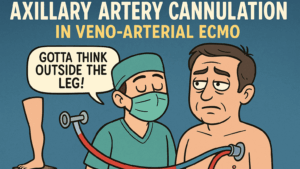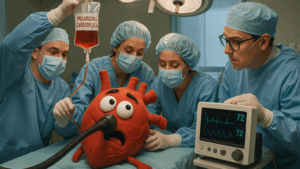Vasoplegic syndrome (VS) represents a significant clinical challenge in cardiac surgery, particularly in procedures involving cardiopulmonary bypass (CPB). Characterized by profound vasodilation, hypotension unresponsive to catecholamines, and high cardiac output with low systemic vascular resistance, VS is a life-threatening condition that can drastically increase patient morbidity and mortality.
This editorial by Unic-Stojanovic et al. published in Interdisciplinary CardioVascular and Thoracic Surgery outlines the current landscape of VS diagnosis, treatment, and research. The syndrome lacks a universally accepted definition, which complicates the identification of its true incidence and effective therapeutic pathways. Often occurring within the first 24 hours post-surgery, VS may be mistakenly attributed to common transient hypotension at CPB initiation. However, true VS involves deeper pathophysiological mechanisms that require prompt and specialized management.
Multiple patient-specific and surgical risk factors contribute to VS. Advanced age, anemia, renal dysfunction, sepsis, and preoperative use of drugs such as ACE inhibitors and beta-blockers are prominent contributors. Surgical complexities including prolonged CPB, redo surgeries, and extensive cross-clamp times further elevate the risk.
Pathophysiologically, VS is driven largely by an inflammatory cascade initiated during CPB. The activation of inducible nitric oxide synthase (iNOS) leads to an overproduction of nitric oxide (NO), stimulating cyclic guanosine monophosphate (cGMP) pathways and resulting in persistent vasodilation. This not only impairs vascular tone but also creates resistance to standard vasopressor therapy. Additional mediators such as prostacyclins, endotoxins, and oxidative stress compounds exacerbate the situation.
The article underscores the need for early diagnosis and intervention, but current scoring systems and clinical guidelines are insufficiently developed. Standard treatment still relies on high-dose catecholamines like norepinephrine and dopamine. However, these agents can lose efficacy over time and pose risks including arrhythmias, myocardial ischemia, and compromised end-organ perfusion.
Amid growing interest in alternative treatments, methylene blue has emerged as a particularly promising agent. A unique pharmacologic profile allows methylene blue to inhibit both iNOS and guanylate cyclase, thereby suppressing NO synthesis and limiting cGMP-mediated vasodilation. Importantly, it also restores responsiveness to catecholamines. A recent meta-analysis highlighted its superiority in reducing mortality risk compared to other non-catecholamine agents like vasopressin and angiotensin II.
Despite its promise, methylene blue’s clinical utility remains underexplored due to the limited size and design quality of existing trials. Some studies support prophylactic use in high-risk patients, while others restrict it to rescue therapy. Regulatory guidelines are beginning to reflect its potential; the 2024 EACTS/EACTAIC/EBCP Guidelines gave methylene blue a Class IIa, Level B recommendation for treating VS in adults undergoing cardiac surgery.
The article also delves into other adjunctive therapies, such as hydroxocobalamin, ascorbic acid, corticosteroids, and calcium supplementation, all of which play roles in restoring vascular tone and improving vasopressor efficacy. However, each has limitations and possible adverse effects ranging from serotonin syndrome (in the case of methylene blue combined with serotonergic drugs) to renal impairment and hemolytic anemia.
An additional concern addressed is the monitoring of adverse effects and drug interactions. Methylene blue, for example, can interfere with pulse oximetry and blood gas analyzers, while also posing risks like methaemoglobinaemia and rebound hypotension. These considerations emphasize the need for cautious and individualized application of therapy.
In terms of future directions, the authors advocate for large-scale, double-blind randomized controlled trials to firmly establish methylene blue’s efficacy, optimal dosing strategies, and long-term safety profile. They also call for a standardized, consensus-based definition of VS to unify diagnostic and treatment approaches globally. Enhanced risk stratification tools could help personalize perioperative care and preemptively identify high-risk patients.
In conclusion, vasoplegic syndrome remains a complex and serious postoperative complication in cardiac surgery. Methylene blue offers a biologically plausible and increasingly evidence-supported intervention that merits broader clinical adoption and further rigorous study. As cardiac surgeries grow more complex and patient populations more vulnerable, refining VS management protocols becomes ever more critical to improving outcomes in cardiovascular care.







